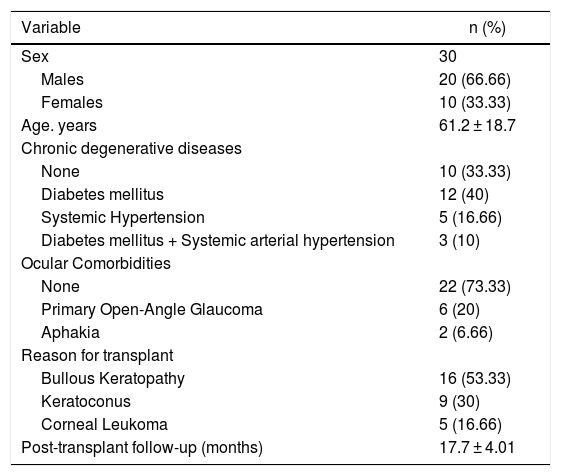Organ and tissue donation and transplantation represent the most important therapeutic advance of current times. The cornea is, by far, one of the most transplanted tissues worldwide due to the immune privilege of this tissue, as well as the advances in microsurgery, existence of cornea banks, preservation of corneas, and use of anti-rejection therapy. However, many patients with successful corneal transplants (with clear corneas) experience poor vision in the post-operative period due to irregular astigmatism, or other complications.
ObjectiveTo evaluate the quality of life related to vision in patients undergoing penetrating keratoplasty.
Material and methodsa cross-analytical study including patients with a history of penetrating keratoplasty, over 18 years of age, and at least 6 months after surgery. The patients answered the visual function questionnaire VFQ-25 (Visual Function Questionnaire), a tool validated for use in Spanish, in which, the higher the score, the better the quality of life.
ResultsThirty patients, 20 men and 10 women, with a mean age of 61.2 ± 18.7 years, were included. The time of evolution after the transplant was 17.7 ± 4 months. The total quality of life score was 74.9 ± 21.9, with significance in visual acuity (p < .001), and the presence of systemic comorbidities (p = .018). There was no significance between the transplant reason (p = .098), or ocular comorbidities (p = .119).
ConclusionThe results suggest that visual acuity, as well as the presence of systemic comorbidities, has a significant impact on quality of life.
La donación y trasplante de órganos y tejidos representan el avance terapéutico más importante de los tiempos actuales. La córnea es, por mucho, uno de los tejidos más trasplantados a nivel mundial gracias a los privilegios inmunológicos encontrados en este tejido, además de los avances en microcirugía, existencia de bancos corneales, preservación de córneas y aplicación de terapia contra el rechazo. Sin embargo, muchos pacientes con trasplantes corneales exitosos (con córneas claras) experimentan mala visión en el periodo postoperatorio por astigmatismo irregular u otras complicaciones.
ObjetivoEvaluar la calidad de vida relacionada con la visión en pacientes sometidos a queratoplastia penetrante.
Material y métodosun estudio transversal-analítico incluyendo pacientes con antecedente de queratoplastia penetrante, mayores de 18 años, y al menos 6 meses de postquirúrgico. Los pacientes respondieron el cuestionario de la función visual VFQ-25 (Visual Function Questionnaire), instrumento validado para su uso en español, el cual, a mayor puntación mejor calidad de vida.
ResultadosSe incluyeron 30 pacientes, 20 hombres y 10 mujeres, con una media de edad de 61.2 ± 18.7 años. El tiempo de evolución posterior al trasplante fue 17.7 ± 4 meses. La puntuación total en la calidad de vida fue 74.9 ± 21.9, con significación estadística en la agudeza visual (p < 0.001), y la presencia de enfermedades sistémicas (p = 0.018). No así entre el motivo de trasplante (p = 0.098), ni enfermedades oculares (p = 0.119).
ConclusiónLos resultados sugieren que la agudeza visual, así como la presencia de enfermedades sistémicas tiene un impacto significativo en la calidad de vida.








